Thekchen Chöling, Dharamsala, HP, India - This morning His Holiness the Dalai Lama walked from the gate to his residence through the courtyard to the veranda below the Tsuglagkhang, the Main Tibetan Temple. Serkhong Rinpoché, who was born in Spiti, led the way, incense in hand. His Holiness stopped to bless the various objects, malas, bottles of water, sacred images and so forth, laid out for the purpose on several tables. Women in their traditional best clothes lined the aisle to greet him, jugs of milk and curd in their hands. His Holiness smiled warmly and waved to the 1300 or so people of all ages from Spiti as they sat on either side of the courtyard.
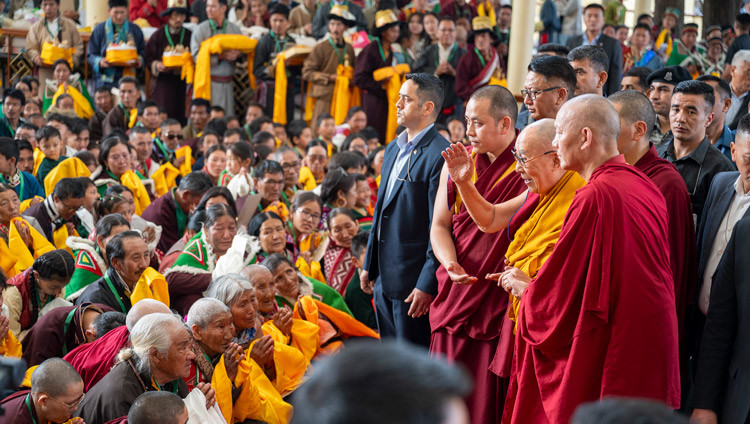
Once His Holiness had taken his seat, Serkhong Rinpoché offered him a mandala and representations of the body, speech and mind of the Buddha. He then sat down to His Holiness’s right next to a small boy who is the reincarnation of the former Abbot of Tabo. A group representing the people of Spiti carried a series of offerings past the throne. The entire gathering recited the prayer for His Holiness’s long life composed by his two tutors, Ling Rinpoché and Trijang Rinpoché.
Addressing the monastics and lay-people seated before him, His Holiness began:
“My Dharma friends, what I want to tell you is that when I came into exile in India, I discovered there were communities of people in the North-west regions of the country who placed their faith and trust in me. People in Tibet have a devout trust in me and you people from Spiti and the Transhimalayan region have shown a similar dedication and helped me where you can. You are loyal and devoted.
“I have the name Dalai Lama, which by itself doesn’t mean very much, but since I was recognized as a child, I have studied Awareness and Knowledge (Tib. lo rig) and Signs and Reasoning (Tib. ta rig)—logic and reasoning—as well as the Perfection of Wisdom and Middle Way philosophy. Then came Higher Knowledge (Abhidharma), which I found difficult because much of what it contains cannot be verified. Next, I studied Vinaya and after that, Tantra.
“I have found that Buddhism has a great deal to offer in terms of understanding the workings of the mind and how to tackle our emotions. My faith in the Buddha is founded on understanding what he taught. Because of this I meditate on the awakening mind of bodhichitta and the view of emptiness every morning as soon as I wake.
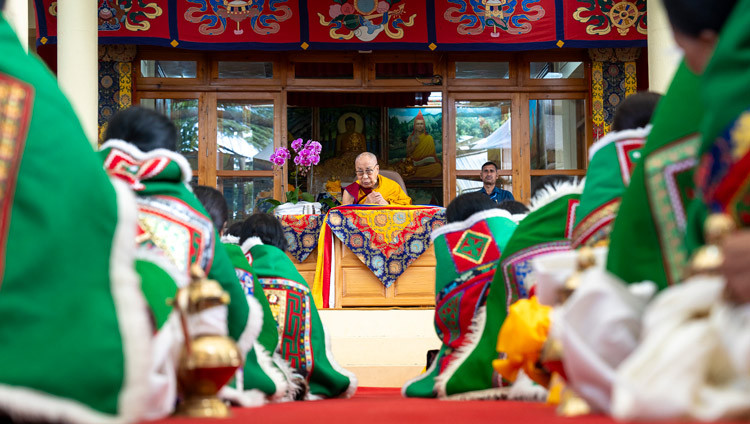
“What’s more, whenever I can I advise people to be kind and explain how things are empty of inherent existence.
“In China people have faith, but they don’t study very much. This is why I think our Tibetan tradition could help interested Chinese people understand Buddhism better.
“Those of you who take an interest in the teaching of the Buddha may know that it is not so much about prayers and recitations. What we need to do is study. Then, when we understand how the teaching works, we have faith based on knowledge.
“Today, you people from Spiti, and particularly the region around Tabo, have offered prayers for my long life. I believe that what makes such prayers effective doesn’t depend on saying prayers for a week, but on whether you make the prayer from the depth of your heart. This is where I live and you’ve come here for the explicit purpose of making prayers that I will live long. You’ve done so with a strong sense of affection and respect and I thank you.”
His Holiness remarked that the many people gathered before him had asked if he might give a brief teaching. He recalled that the Buddha, moved by the suffering of others, gave up his comfortable royal life and engaged in austerities in search of a solution. Ultimately, he attained enlightenment at Bodhgaya, an accomplishment much more significant than achieving simple satisfaction in this life alone.
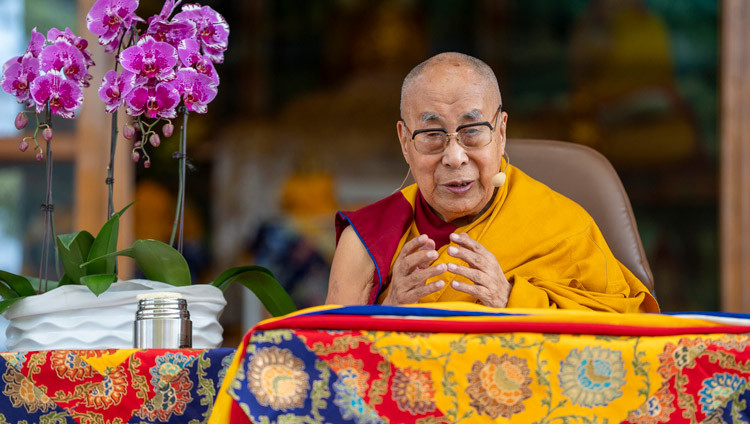
His Holiness announced that he would conduct a short ceremony generate the awakening mind of bodhichitta. He noted that the people before him had gathered out of single-pointed faith and that the bond between them and him was strong.
“I am a follower of the Buddha,” he observed, “a Buddhist monk. I received ordination as a novice and then as a bhikshu (a fully ordained monk) in front of the Jowo statue in Lhasa. I am a sincere follower of the Buddha, someone who strongly identifies with being a Buddhist monk. I observe the three vows, the individual emancipation, bodhisattva and tantric vows.
“Not so long ago, I was in a temple where I had a vision of the Buddha before me. He beckoned and I approached. He seemed pleased with me and patted me on the head. I had only a single chocolate to offer him which he accepted. However, I felt that by keeping the three vows and teaching others, I had made an offering of practice to the Buddha.
“Similarly, you have offered these prayers for my long life, not out of any sense of obligation, but because you really wish I will live long. This is a true long-life offering and I’m happy to accept it.
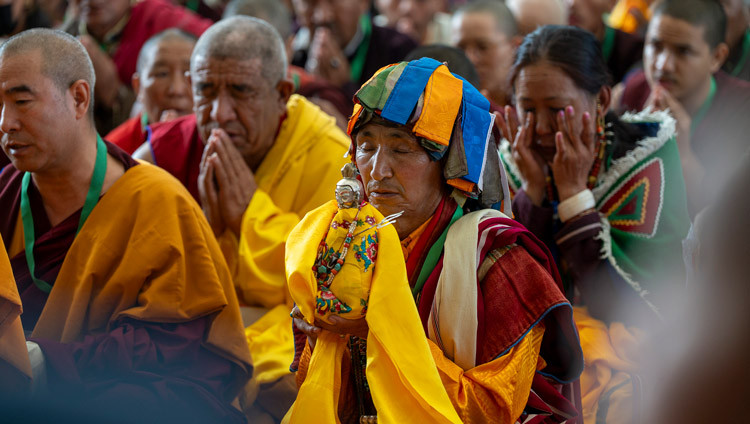
“The essence of the Dharma is bodhichitta and to generate it now please repeat these lines three times after me:
I go for refuge until I am enlightened
To the Buddha, the Dharma, and the Supreme Assembly,
In order to fulfil the aims of myself and others
I develop the awakening mind.
“The Buddha explained that things appear in certain ways, but they do not actually exist the way they appear. If you analyse everything that appears to you, you’ll find none of them exist in and of themselves. Things do not exist from their own side; they exist only by way of designation.
“If you look at me you can ask is the Dalai Lama in my head, my forehead, my upper torso, my legs? None of these are the Dalai Lama. He is neither the parts of his body nor his voice. The Dalai Lama exists by way of designation on these parts. That things exist only by way of designation is the most powerful teaching of the Buddha. However, our unruly minds tend to cling on to the idea that things exist as they appear.
“If you don’t find me among the parts of my body, does that mean I don’t exist? No, but analysis reveals that I exist only by way of designation.”
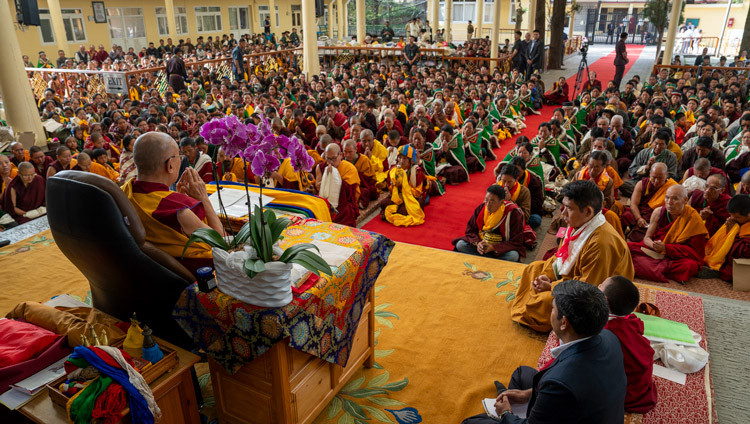
His Holiness then asked the congregation to repeat after him as he gave transmission of the mantras of the Buddha, Avalokiteshvara, Tara and Padmasambhava.
To conclude the long-life ceremony, a group of women from Tabo, each wearing a green Spiti cloak, sang verses of auspiciousness to His Holiness who turned to face them and listened carefully. He then stepped down to sit in the midst of the crowd while photographs were taken of them altogether.
Next, His Holiness took the lift up to the main temple where a group of monks belonging to Namgyal Monastery were performing rituals invoking Vajrakilaya or Dorjé Phurba. They have been doing this for several days, having already created a mandala and a requisite array of ritual cakes, in order to consecrate pills that will later be made available to the public. His Holiness sat on a chair in front of the throne and took part in the recitations for about a quarter of an hour.
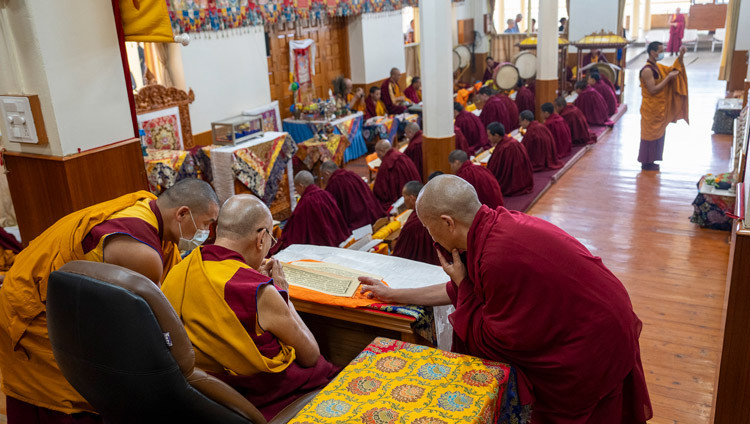
Subsequently he left the temple, rode the lift down to the courtyard and walked to the electric golf cart that would take him home, smiling and waving to members of the crowd as he went.












